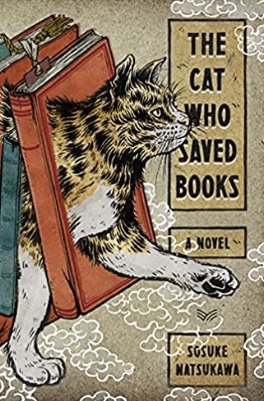The Cat Who Saved Books by Sosuke Natsukawa, translated by Louise Heal Kawai (HarperVia)
Rintaro Natsuki is a teenage orphan whose grandfather, the man who brought him up, has recently died. A reclusive boy, Rintaro is well on his way to becoming a hikikomori, a hermit who clings to solitude and is deaf to social cues. He spends almost all of his time in the secondhand bookshop that his grandfather owned and nurtured, a place where Rintaro is able to hide away and burrow into the pages of a book. Now that he’s alone in the world with only an aunt whom he barely knows offering him a home, Rintaro stays in the bookshop, ignoring both his school and the classmates who try to lure him back outside. Although he knows he needs to close Natsuki Books, he refuses to leave its walls until one night a visitor shows up--one who’s too unusual for even Rintaro to ignore.
“I need your help. There are books that have been imprisoned.” This statement borders on madness, especially because it comes from the voice of a large plump tabby cat.
Not only is this a feline with the power of human speech, it’s one that’s mastered the art of sarcasm and quotes Antoine Saint-Exupery. Rintaro, despite his natural misanthropic inclinations, lets the feline draw him into four separate adventures, each involving the future of the printed word.
There aren’t many writers who can bring adult readers into a world of youthful fantasy and keep them there, riveted and captivated. Sosoke Natsukawa’s The Cat Who Saved Books takes its place beside C.S. Lewis’ Chronicles of Narnia and Madeline L’Engle’s A Wrinkle in Time as a work of imagination that knows no age barriers.
Much of this, at least at first, is due to the sardonic, sarcastic cat who keeps Natsukawa’s book from falling into an overload of sweetness and whimsy. This feline is no Disney character. He’s mean.
As he lures his teenage comrade into missions that are impossible for Rintaro to refuse, they sweep up anybody who loves bookstores, books, and the act of reading. The threats that the cat urges his follower to combat are ones that imperil the literary world even now and the weapons that Rintaro finds within himself to combat them will resonate with every reader.
Whether he encounters the speed-demon who believes the importance of reading is found in the number of books consumed rather than in the act of rereading, considering, and savoring them, or the man who tears books apart to distill them into one or two easily read sentences, Rintaro is able to point out the flaws in these beliefs. More difficult and more dangerous are the final two opponents that the cat brings to light.
The publisher who believes the only books that should survive are the ones that will sell in huge numbers brings to mind trends in current publishing houses and slows this break-neck plot into one that evokes into thought and terror. Not only could this happen, it is happening. Then comes the soul of a book that’s survived for almost 2000 years but realizes it’s losing its power. What can keep it from being “just another bundle of paper?”
“I’m showing you the gap between idealism and reality,” it tells Rintaro, who feels the lure of cynicism and defeat. His response is one to remember and to reread, one that will shape young readers and hearten those who are older.
This quiet little book is one that will become a classic for everyone who treasures the art of reading, the solace of a bookstore, and the dazzling power exerted by pages that have been printed, bound, and brought to life.~Janet Brown
